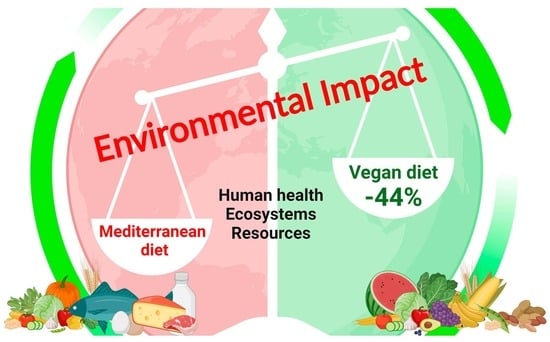Environmental Impact of Two Plant-Based, Isocaloric and Isoproteic Diets: The Vegan Diet vs. the Mediterranean Diet
Abstract
1. Introduction
2. Materials and Methods
3. Results
3.1. Characterization
3.2. Damage Assessment
3.3. Normalization
3.4. Weighted Average to Obtain a Single Score
4. Discussion
5. Limitations
6. Conclusions
Author Contributions
Funding
Institutional Review Board Statement
Informed Consent Statement
Data Availability Statement
Acknowledgments
Conflicts of Interest
Appendix A. Process Contribution
| Process | Project | Unit | Vegan | Mediterranean |
|---|---|---|---|---|
| Almond {GLO}| market for almond | Cut-off, S | Ecoinvent 3 a | Pt | 0.0604 | 0.0575 |
| Aubergine {GLO}| market for | Cut-off, S | Ecoinvent 3 a | Pt | 0.0147 | 0.0147 |
| Bell pepper {GLO}| market for bell pepper | Cut-off, S | Ecoinvent 3 a | Pt | 0.0506 | 0.0506 |
| Cashew {GLO}| market for cashew | Cut-off, S | Ecoinvent 3 a | Pt | 0.0216 | 0.0205 |
| Cheese, from cow milk, fresh, unripened {GLO}| cheese production, soft, from cow milk | Cut-off, S | Ecoinvent 3 a | Pt | x | 0.0743 |
| Chickpea {GLO}| market for chickpea | Cut-off, S | Ecoinvent 3 a | Pt | 0.0107 | 0.0049 |
| Cucumber {GLO}| market for | Cut-off, S | Ecoinvent 3 a | Pt | 0.0253 | 0.0253 |
| Electricity, low voltage {GLO}| market group for | Cut-off, S—Copied from ecoinvent | World Food LCA Database | Pt | 0.0205 | 0.0200 |
| Fish, marine {GLO}| market for marine fish | Cut-off, S | Ecoinvent 3 a | Pt | x | 0.0206 |
| Gas stove | Diets’ comparison | Pt | 0.0217 | 0.0192 |
| Green asparagus {GLO}| market for | Cut-off, S | Ecoinvent 3 a | Pt | 0.0173 | 0.0173 |
| Lentil, at farm/AU Economic | Agri-footprint—economic allocation | Pt | 0.0107 | 0.0048 |
| Lettuce {GLO}| market for | Cut-off, S | Ecoinvent 3 a | Pt | 0.0272 | 0.0272 |
| Natural gas, high pressure {IT}| market for | Cut-off, S | Ecoinvent 3 a | Pt | 0.0111 | 0.0098 |
| Peanut {GLO}| market for peanut | Cut-off, S | Ecoinvent 3 a | Pt | 0.0162 | 0.0155 |
| Red meat, live weight {GLO}| market for | Cut-off, S | Ecoinvent 3 a | Pt | x | 0.3345 |
| Rice, non-basmati {GLO}| market for rice, non-basmati | Cut-off, S | Ecoinvent 3 a | Pt | 0.0151 | 0.0151 |
| Skimmed milk, from cow milk {GLO}| market for | Cut-off, S | Ecoinvent 3 a | Pt | x | 0.0844 |
| Sodium chloride, powder {RER}| production | Cut-off, S | Ecoinvent 3 a | Pt | 0.0175 | 0.0004 |
| Wastewater, unpolluted {CH}| treatment of, capacity 5E9l/year | Cut-off, S | Ecoinvent 3 a | Pt | 0.0249 | 0.0249 |
| Wheat grain {RoW}| wheat production | Cut-off, S | Ecoinvent 3 a | Pt | 0.0874 | 0.0785 |
| Remaining processes | Pt | 0.1644 | 0.1799 | |
| All processes | Pt | 0.6173 | 1.0998 | |
| Animal foods | Pt | 0.0000 | 0.5138 (47%) |


| Food Group | Quantity (kg), Pts and % | |||||
|---|---|---|---|---|---|---|
| Vegan Diet | Mediterranean Diet | |||||
| Quantity | Pts | % | Quantity | Pts | % | |
| Mixed cooked cereals | 1.12 | 0.021 | 3.34 | 1.12 | 0.021 | 1.88 |
| Cooked rice | 0.72 | 0.019 | 3.14 | 0.72 | 0.019 | 1.76 |
| Spaghetti | 1.68 | 0.087 | 14.2 | 1.68 | 0.087 | 7.91 |
| Bread | 0.66 | 0.046 | 7.55 | 0.66 | 0.046 | 4.24 |
| Olive oil | 0.08 | 0.007 | 1.20 | 0.14 | 0.013 | 1.18 |
| Mixed cooked legumes | 0.88 | 0.043 | 6.95 | 0.40 | 0.019 | 1.77 |
| Mixed fruit | 2.63 | 0.046 | 7.47 | 2.10 | 0.037 | 3.35 |
| Mixed cooked vegetables | 4.20 | 0.186 | 30.00 | 4.20 | 0.186 | 16.9 |
| Nuts | 0.42 | 0.098 | 15.9 | 0.40 | 0.093 | 8.51 |
| Sunflower oil | 0.06 | 0.010 | 1.57 | x | ||
| Soy dessert | 0.25 | 0.007 | 1.17 | x | ||
| Soy drink | 0.80 | 0.011 | 1.82 | x | ||
| Seitan | 0.06 | 0.029 | 4.70 | x | ||
| Tofu | 0.16 | 0.007 | 10.5 | x | ||
| Cheese | x | 0.21 | 0.104 | 9.49 | ||
| Cooked fish | x | 0.12 | 0.021 | 1.89 | ||
| Cooked red meat | x | 0.06 | 0.333 | 30.04 | ||
| Skimmed milk | x | 1.40 | 0.084 | 7.68 | ||
| Cooked chicken | x | 0.12 | 0.014 | 1.27 | ||
| Cooked egg | x | 0.12 | 0.200 | 1.80 | ||
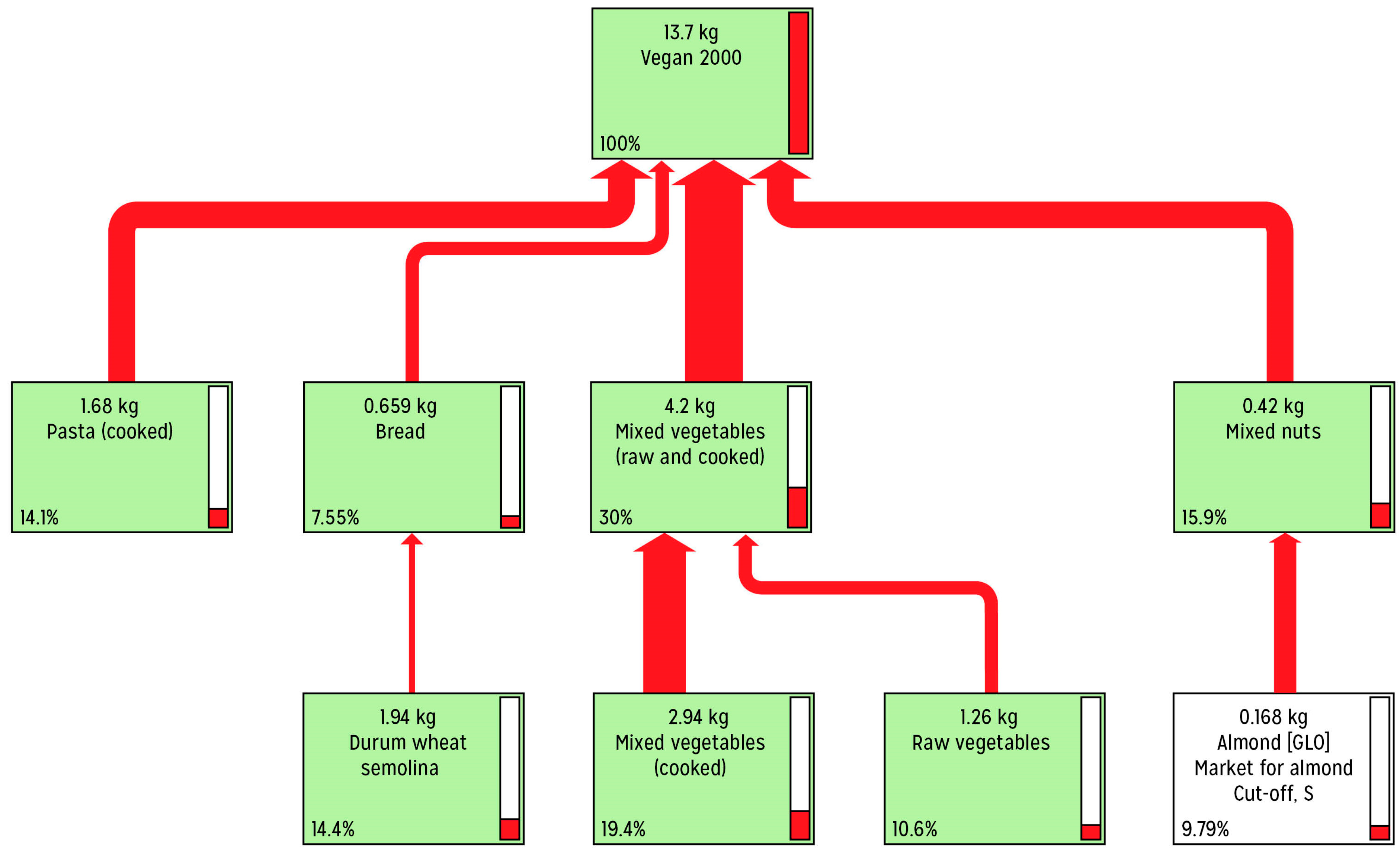
Appendix B. Single Issues: Comparison of the Two Diets by the IPCC 2013
| Impact Category | Unit | Vegan Diet | Mediterranean Diet | Δ Veg-Med | % |
|---|---|---|---|---|---|
| IPCC GWP 100a | Kg CO2-eq | 12.9 | 16.4 | −3.5 | −21.34 |
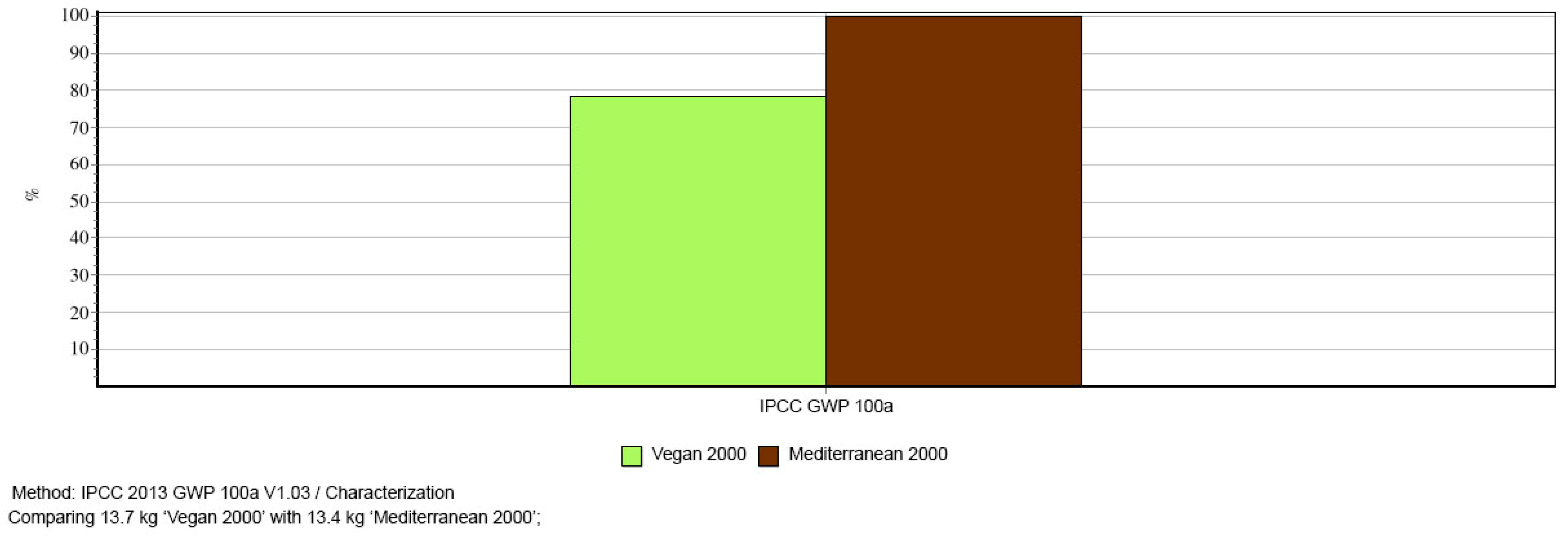
Appendix C. Calculation of Protein Plant Foods vs. Protein Animal Foods: Two Examples
Appendix C.1. Comparison between Soy Milk and Cow Milk
| Aggregated Weighted Average (Single Score) | |||||
|---|---|---|---|---|---|
| Impact Category | Unit | Soy Milk | Cow Milk | Δ Soy-Cow | % |
| Global warming, Human health | mPt | 3.7999 | 23.9929 | −20.1930 | −84.16 |
| Global warming, Terrestrial ecosystems | mPt | 0.5068 | 3.1975 | −2.6907 | −84.15 |
| Global warming, Freshwater ecosystems | mPt | 1.38 × 10−5 | 8.73 × 10−5 | −7.35 × 10−5 | −84.15 |
| Stratospheric ozone depletion | mPt | 1.32 × 10−2 | 5.51 × 10−2 | −4.20 × 10−2 | −76.13 |
| Ionizing radiation | mPt | 0.98 × 10−3 | 4.57 × 10−3 | −3.59 × 10−3 | −78.46 |
| Ozone formation, Human health | mPt | 1.41 × 10−2 | 8.61 × 10−2 | −7.20 × 10−2 | −83.63 |
| Fine particulate matter formation | mPt | 3.8525 | 20.0071 | −16.2182 | −80.81 |
| Ozone formation, Terrestrial ecosystems | mPt | 0.90 × 10−1 | 5.44 × 10−1 | −4.54 × 10−1 | −83.43 |
| Terrestrial acidification | mPt | 0.1635 | 1.3701 | −1.2066 | −88.07 |
| Freshwater eutrophication | mPt | 2.64 × 10−2 | 8.00 × 10−2 | −5.36 × 10−2 | −67.02 |
| Marine eutrophication | mPt | 5.67 × 10−4 | 9.10 × 10−4 | −3.43 × 10−4 | −37.66 |
| Terrestrial ecotoxicity | mPt | 1.24 × 10−2 | 1.39 × 10−2 | −0.15 × 10−2 | −10.81 |
| Freshwater ecotoxicity | mPt | 4.05 × 10−3 | 8.62 × 10−3 | −4.57 × 10−3 | −53.03 |
| Marine ecotoxicity | mPt | 8.58 × 10−4 | 14.38 × 10−4 | −5.80 × 10−4 | −40.33 |
| Human carcinogenic toxicity | mPt | 3.32 × 10−1 | 7.75 × 10−1 | −4.43 × 10−1 | −57.13 |
| Human non-carcinogenic toxicity | mPt | 0.8328 | 1.9615 | −1.1288 | −57.55 |
| Land use | mPt | 2.6577 | 7.5275 | −4.8698 | −64.69 |
| Mineral resource scarcity | mPt | 0.23 × 10−2 | 2.42 × 10−2 | −2.19 × 10−2 | −90.65 |
| Fossil resource scarcity | mPt | 3.48 × 10−1 | 4.36 × 10−1 | −0.88 × 10−1 | −20.19 |
| Water consumption, Human health | mPt | −0.25 × 10−1 | 2.37 × 10−1 | −2.62 × 10−1 | −110.41 |
| Water consumption, Terrestrial ecosystem | mPt | 1.10 × 10−2 | 6.98 × 10−2 | −5.88 × 10−2 | −84.26 |
| Water consumption, Aquatic ecosystems | mPt | 1.30 × 10−5 | 1.26 × 10−5 | 0.04 × 10−5 | 3.01 |
| Damage category | |||||
| Human health | mPt | 8.8210 | 47.1832 | −38.3622 | −81.30 |
| Ecosystems | mPt | 3.4732 | 12.8134 | −9.3402 | −72.89 |
| Resources | mPt | 0.3500 | 0.4599 | −0.1099 | −23.90 |
| Total | mPt | 12.6442 | 60.4566 | −47.8124 | −79.09 |
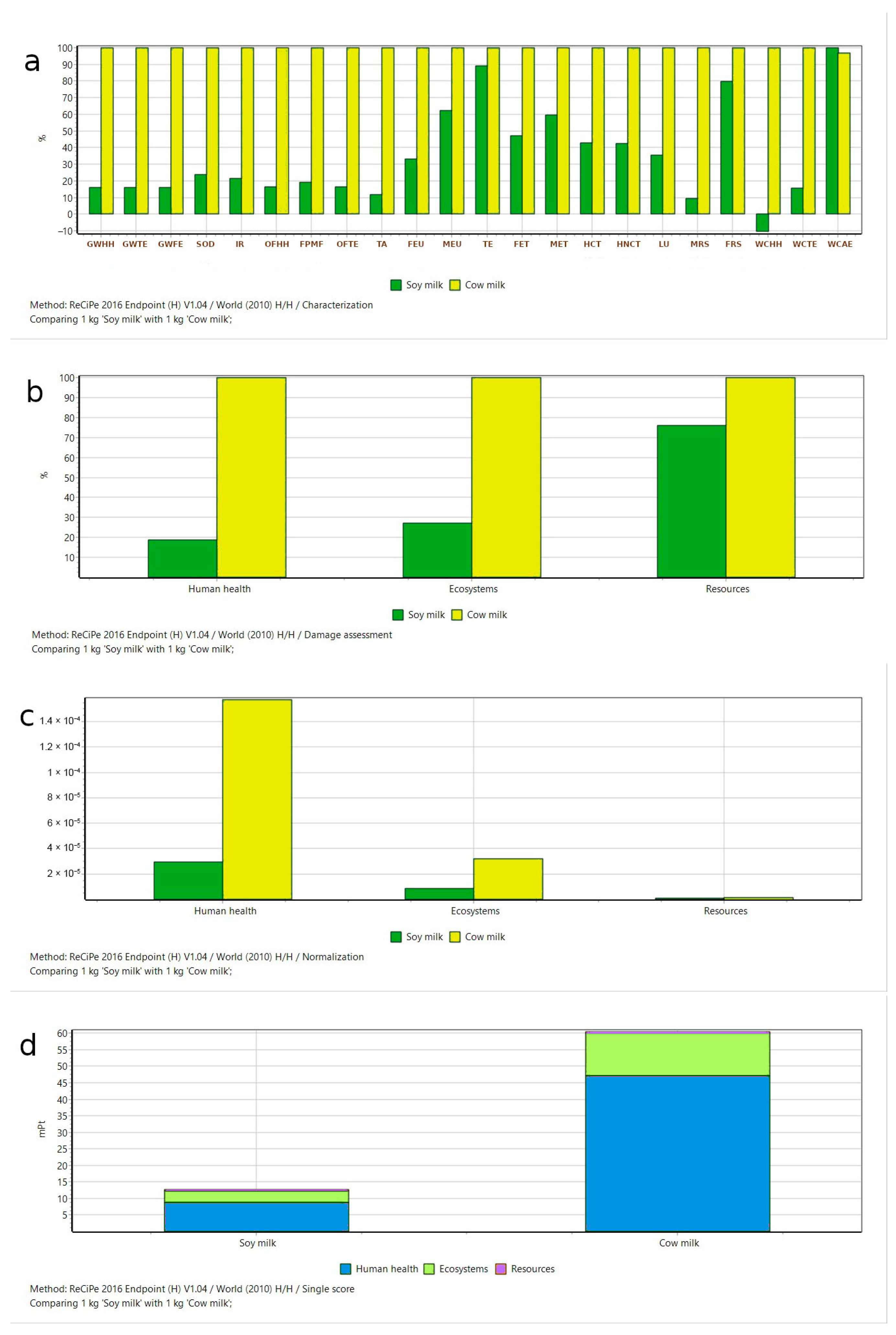
Appendix C.2. Comparison among Cooked Mixed Meat, Seitan, and Mixed Legumes
| Impact Category | Unit | Mixed Meat (Cooked) | Seitan | Mixed Legumes (Cooked) | Δ Seitan-Meat | Δ Legumes-Meat | % Seitan-Meat | % Legumes-Meat |
|---|---|---|---|---|---|---|---|---|
| Global warming, Human health | mPt | 2.68 × 102 | 1.13 × 102 | 0.41 × 102 | −1.54 × 102 | −2.27 × 102 | −57.62 | −84.67 |
| Global warming, Terrestrial ecosystems | mPt | 3.57 × 101 | 1.51 × 101 | 0.55 × 101 | −2.05 × 101 | −3.02 × 101 | −57.58 | −84.65 |
| Global warming, Freshwater ecosystems | mPt | 9.75 × 10−4 | 4.13 × 10−4 | 1.50 × 10−4 | −5.61 × 10−4 | −8.25 × 10−4 | −57.58 | −84.65 |
| Stratospheric ozone depletion | mPt | 9.21 × 10−1 | 3.53 × 10−1 | 0.67 × 10−1 | −5.68 × 10−1 | −8.53 × 10−1 | −61.67 | −92.69 |
| Ionizing radiation | mPt | 4.53 × 10−2 | 16.9 × 10−2 | 0.15 × 10−2 | 12.41 × 10−2 | −4.39 × 10−2 | 273.81 | −96.74 |
| Ozone formation, Human health | mPt | 9.00 × 10−1 | 2.54 × 10−1 | 0.33 × 10−1 | −6.46 × 10−1 | −8.67 × 10−1 | −71.77 | −96.35 |
| Fine particulate matter formation | mPt | 2.48 × 102 | 1.45 × 102 | 0.17 × 102 | −1.03 × 102 | −2.31 × 102 | −41.56 | −93.12 |
| Ozone formation, Terrestrial ecosystems | mPt | 5.6807 | 1.6191 | 0.2102 | −4.0615 | −5.4704 | −71.50 | −96.30 |
| Terrestrial acidification | mPt | 18.3136 | 6.6124 | 1.2052 | −11.7012 | −17.1084 | −63.89 | −93.42 |
| Freshwater eutrophication | mPt | 1.1521 | 2.8497 | 0.0820 | 1.6976 | −1.0701 | 147.35 | −92.88 |
| Marine eutrophication | mPt | 2.14 × 10−2 | 0.65 × 10−2 | 0.27 × 10−2 | −1.49 × 10−2 | −1.87 × 10−2 | −69.77 | −87.53 |
| Terrestrial ecotoxicity | mPt | 1.51 × 10−1 | 6.41 × 10−1 | 0.41 × 10−1 | 4.89 × 10−1 | −1.10 × 10−1 | 323.22 | −72.81 |
| Freshwater ecotoxicity | mPt | 1.03 × 10−1 | 7.28 × 10−1 | 0.20 × 10−1 | 6.25 × 10−1 | −0.83 × 10−1 | 604.28 | −80.54 |
| Marine ecotoxicity | mPt | 2.09 × 10−2 | 14.11 × 10−2 | 0.33 × 10−2 | 12.01 × 10−2 | −1.76 × 10−2 | 573.69 | −84.28 |
| Human carcinogenic toxicity | mPt | 9.9775 | 27.6797 | 0.5171 | 17.7022 | −9.4604 | 177.42 | −94.82 |
| Human non-carcinogenic toxicity | mPt | 2.49 × 101 | 8.56 × 101 | 1.83 × 101 | 6.07 × 101 | −0.66 × 101 | 243.31 | −26.45 |
| Land use | mPt | 9.16 × 101 | 5.24 × 101 | 2.26 × 101 | −3.92 × 101 | −6.90 × 101 | −42.74 | −75.28 |
| Mineral resource scarcity | mPt | 2.93 × 10−1 | 3.20 × 10−1 | 0.06 × 10−1 | 0.27 × 10−1 | −2.87 × 10−1 | 9.26 | −97.99 |
| Fossil resource scarcity | mPt | 5.5237 | 6.4076 | 2.4128 | 0.8839 | −3.1109 | 16.00 | −56.32 |
| Water consumption, Human health | mPt | 2.7328 | 0.1934 | 2.2419 | 0.1661 | −0.4909 | 607.75 | −17.96 |
| Water consumption, Terrestrial ecosystem | mPt | 9.06 × 10−1 | 53.93 × 10−1 | 6.97 × 10−1 | 44.86 × 10−1 | −2.10 × 10−1 | 494.96 | −23.13 |
| Water consumption, Aquatic ecosystems | mPt | 1.46 × 10−4 | 8.55 × 10−4 | 2.95 × 10−4 | 7.09 × 10−4 | 1.49 × 10−4 | 485.29 | 101.84 |
| Damage Category | ||||||||
| Human health | mPt | 5.55 × 102 | 3.92 × 102 | 0.79 × 102 | −1.63 × 102 | −4.76 × 102 | −29.42 | −85.71 |
| Ecosystems | mPt | 15.4 × 101 | 8.56 × 101 | 3.04 × 101 | −6.81 × 101 | −12.33 × 101 | −44.30 | −80.22 |
| Resources | mPt | 5.8167 | 6.7277 | 2.4187 | 0.0911 | −3.3979 | 15.66 | −58.42 |
| Total | mPt | 7.14 × 102 | 4.84 × 102 | 1.12 × 102 | −2.30 × 102 | −6.02 × 102 | −32.26 | −84.31 |
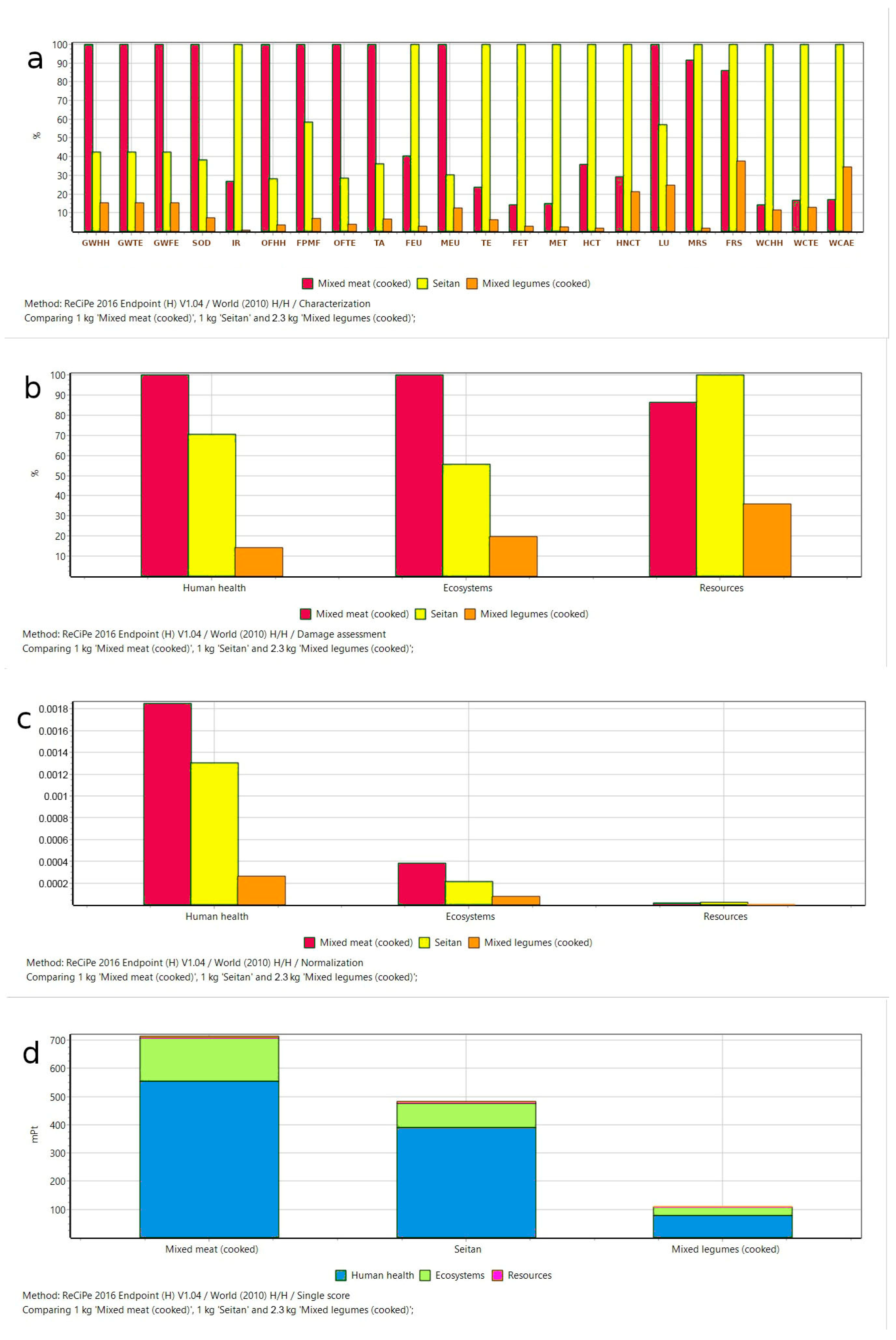
References
- World Commission on Environment and Development. Our Common Future. Available online: https://sustainabledevelopment.un.org/content/documents/5987our-common-future.pdf (accessed on 22 November 2022).
- McMichael, A.J.; Butler, C.D.; Dixon, J. Climate Change, Food Systems and Population Health Risks in Their Eco-Social Context. Public Health 2015, 129, 1361–1368. [Google Scholar] [CrossRef] [PubMed]
- Banterle, A.; Ricci, E.C.; Cavaliere, A. Environmental Sustainability and the Food System. In Regulating and Managing Food Safety in the EU; Bremmers, H., Purnhagen, K., Eds.; Springer International Publishing: Cham, Switzerland, 2018; pp. 57–88. ISBN 978-3-319-77043-7. [Google Scholar]
- FAO and WHO. Sustainable Healthy Diets: Guiding Principles. Available online: https://www.who.int/publications/i/item/9789241516648 (accessed on 22 November 2022).
- Drewnowski, A.; Finley, J.; Hess, J.M.; Ingram, J.; Miller, G.; Peters, C. Toward Healthy Diets from Sustainable Food Systems. Curr. Dev. Nutr. 2020, 4, nzaa083. [Google Scholar] [CrossRef] [PubMed]
- Masson-Delmotte, V. Climate Change and Land: An IPCC Special Report on Climate Change, Desertification, Land Degradation, Sustainable Land Management, Food Security, and Greenhouse Gas Fluxes in Terrestrial Ecosystems: Summary for Policymakers; Intergovernmental Panel on Climate Change: Geneva, Switzerland, 2019. [Google Scholar]
- Ritchie, H. Half of the World’s Habitable Land Is Used for Agriculture. Available online: https://ourworldindata.org/global-land-for-agriculture (accessed on 22 November 2022).
- Zabel, F.; Putzenlechner, B.; Mauser, W. Global Agricultural Land Resources–A High Resolution Suitability Evaluation and Its Perspectives until 2100 under Climate Change Conditions. PLoS ONE 2014, 9, e107522. [Google Scholar] [CrossRef] [PubMed]
- Ridoutt, B.G.; Hendrie, G.A.; Noakes, M. Dietary Strategies to Reduce Environmental Impact: A Critical Review of the Evidence Base. Adv. Nutr. 2017, 8, 933–946. [Google Scholar] [CrossRef] [PubMed]
- Baroni, L.; Cenci, L.; Tettamanti, M.; Berati, M. Evaluating the Environmental Impact of Various Dietary Patterns Combined with Different Food Production Systems. Eur. J. Clin. Nutr. 2007, 61, 279–286. [Google Scholar] [CrossRef]
- Baroni, L.; Berati, M.; Candilera, M.; Tettamanti, M. Total Environmental Impact of Three Main Dietary Patterns in Relation to the Content of Animal and Plant Food. Foods 2014, 3, 443–460. [Google Scholar] [CrossRef]
- Bach-Faig, A.; Berry, E.M.; Lairon, D.; Reguant, J.; Trichopoulou, A.; Dernini, S.; Medina, F.X.; Battino, M.; Belahsen, R.; Miranda, G.; et al. Mediterranean Diet Pyramid Today. Science and Cultural Updates. Public Health Nutr. 2011, 14, 2274–2284. [Google Scholar] [CrossRef]
- Baroni, L.; Goggi, S.; Battino, M. VegPlate: A Mediterranean-Based Food Guide for Italian Adult, Pregnant, and Lactating Vegetarians. J. Acad. Nutr. Diet. 2018, 118, 2235–2243. [Google Scholar] [CrossRef]
- Barahmand, Z.; Eikeland, M.S. Life Cycle Assessment under Uncertainty: A Scoping Review. World 2022, 3, 692–717. [Google Scholar] [CrossRef]
- METEDA©, S.r.l. MètaDieta. Available online: https://www.meteda.it/en/product/metadieta/ (accessed on 5 December 2022).
- Huijbregts, M.A.J.; Steinmann, Z.J.N.; Elshout, P.M.F.; Stam, G.; Verones, F.; Vieira, M.D.M.; Hollander, A.; Zijp, M.; van Zelm, R. ReCiPe 2016 v1.1 A Harmonized Life Cycle Impact Assessment Method at Midpoint and Endpoint Level; National Institute for Public Health and the Environment: Bilthoven, The Netherlands, 2016. [Google Scholar]
- Poore, J.; Nemecek, T. Reducing Food’s Environmental Impacts through Producers and Consumers. Science 2018, 360, 987–992. [Google Scholar] [CrossRef]
- Springmann, M.; Wiebe, K.; Mason-D’Croz, D.; Sulser, T.B.; Rayner, M.; Scarborough, P. Health and Nutritional Aspects of Sustainable Diet Strategies and Their Association with Environmental Impacts: A Global Modelling Analysis with Country-Level Detail. Lancet Planet Health 2018, 2, e451–e461. [Google Scholar] [CrossRef]
- Springmann, M.; Godfray, H.C.J.; Rayner, M.; Scarborough, P. Analysis and Valuation of the Health and Climate Change Cobenefits of Dietary Change. Proc. Natl. Acad. Sci. USA 2016, 113, 4146–4151. [Google Scholar] [CrossRef]
- Springmann, M.; Clark, M.A.; Rayner, M.; Scarborough, P.; Webb, P. The Global and Regional Costs of Healthy and Sustainable Dietary Patterns: A Modelling Study. Lancet Planet Health 2021, 5, e797–e807. [Google Scholar] [CrossRef] [PubMed]
- Pieper, M.; Michalke, A.; Gaugler, T. Calculation of External Climate Costs for Food Highlights Inadequate Pricing of Animal Products. Nat. Commun. 2020, 11, 6117. [Google Scholar] [CrossRef]
- Benton, T.G.; Bieg, C.; Harwatt, H.; Pudasaini, R.; Wellesley, L. Food System Impacts on Biodiversity Loss. In Three Levers for Food System Transformation in Support of Nature; Chatham House: London, UK, 2021. [Google Scholar]
- Eisen, M.B.; Brown, P.O. Rapid Global Phaseout of Animal Agriculture Has the Potential to Stabilize Greenhouse Gas Levels for 30 Years and Offset 68 Percent of CO2 Emissions This Century. PLoS Clim. 2022, 1, e0000010. [Google Scholar] [CrossRef]
- Baroni, L.; Filippin, D.; Goggi, S. Helping the Planet with Healthy Eating Habits. Open Inf. Sci. 2018, 2, 156–167. [Google Scholar] [CrossRef]
- Arrieta, E.M.; Fischer, C.G.; Aguiar, S.; Geri, M.; Fernández, R.J.; Coquet, J.B.; Scavuzzo, C.M.; Rieznik, A.; León, A.; González, A.D.; et al. The Health, Environmental, and Economic Dimensions of Future Dietary Transitions in Argentina. Sustain. Sci. 2022. [Google Scholar] [CrossRef]
- Jennings, R.; Henderson, A.D.; Phelps, A.; Janda, K.M.; van den Berg, A.E. Five U.S. Dietary Patterns and Their Relationship to Land Use, Water Use, and Greenhouse Gas Emissions: Implications for Future Food Security. Nutrients 2023, 15, 215. [Google Scholar] [CrossRef]
- Read, Q.D.; Hondula, K.L.; Muth, M.K. Biodiversity Effects of Food System Sustainability Actions from Farm to Fork. Proc. Natl. Acad. Sci. USA 2022, 119, e2113884119. [Google Scholar] [CrossRef]
- Zucchinelli, M.; Spinelli, R.; Corrado, S.; Lamastra, L. Evaluation of the Influence on Water Consumption and Water Scarcity of Different Healthy Diet Scenarios. J. Environ. Manag. 2021, 291, 112687. [Google Scholar] [CrossRef]
- Chapa, J.; Farkas, B.; Bailey, R.L.; Huang, J.-Y. Evaluation of Environmental Performance of Dietary Patterns in the United States Considering Food Nutrition and Satiety. Sci. Total Environ. 2020, 722, 137672. [Google Scholar] [CrossRef] [PubMed]
- Blackstone, N.T.; El-Abbadi, N.H.; McCabe, M.S.; Griffin, T.S.; Nelson, M.E. Linking Sustainability to the Healthy Eating Patterns of the Dietary Guidelines for Americans: A Modelling Study. Lancet Planet. Health 2018, 2, e344–e352. [Google Scholar] [CrossRef] [PubMed]
- González-García, S.; Esteve-Llorens, X.; Moreira, M.T.; Feijoo, G. Carbon Footprint and Nutritional Quality of Different Human Dietary Choices. Sci. Total Environ. 2018, 644, 77–94. [Google Scholar] [CrossRef] [PubMed]
- Rosi, A.; Mena, P.; Pellegrini, N.; Turroni, S.; Neviani, E.; Ferrocino, I.; Di Cagno, R.; Ruini, L.; Ciati, R.; Angelino, D.; et al. Environmental Impact of Omnivorous, Ovo-Lacto-Vegetarian, and Vegan Diet. Sci. Rep. 2017, 7, 6105. [Google Scholar] [CrossRef] [PubMed]
- Vanham, D.; del Pozo, S.; Pekcan, A.G.; Keinan-Boker, L.; Trichopoulou, A.; Gawlik, B.M. Water Consumption Related to Different Diets in Mediterranean Cities. Sci. Total Environ. 2016, 573, 96–105. [Google Scholar] [CrossRef] [PubMed]
- Ruini, L.F.; Ciati, R.; Pratesi, C.A.; Marino, M.; Principato, L.; Vannuzzi, E. Working toward Healthy and Sustainable Diets: The “Double Pyramid Model” Developed by the Barilla Center for Food and Nutrition to Raise Awareness about the Environmental and Nutritional Impact of Foods. Front. Nutr. 2015, 2, 9. [Google Scholar] [CrossRef]
- Paris, J.M.G.; Falkenberg, T.; Nöthlings, U.; Heinzel, C.; Borgemeister, C.; Escobar, N. Changing Dietary Patterns Is Necessary to Improve the Sustainability of Western Diets from a One Health Perspective. Sci. Total Environ. 2022, 811, 151437. [Google Scholar] [CrossRef]
- Dernini, S.; Berry, E.; Serra-Majem, L.; La Vecchia, C.; Capone, R.; Medina, F.; Aranceta-Bartrina, J.; Belahsen, R.; Burlingame, B.; Calabrese, G.; et al. Med Diet 4.0: The Mediterranean Diet with Four Sustainable Benefits. Public Health Nutr. 2017, 20, 1322–1330. [Google Scholar] [CrossRef]
- UNESCO Mediterranean Diet. Available online: https://ich.unesco.org/en/RL/mediterranean-diet-00884 (accessed on 5 February 2023).
- Portugal-Nunes, C.; Nunes, F.M.; Fraga, I.; Saraiva, C.; Gonçalves, C. Assessment of the Methodology That Is Used to Determine the Nutritional Sustainability of the Mediterranean Diet—A Scoping Review. Front. Nutr. 2021, 8, 772133. [Google Scholar] [CrossRef]
- Dinu, M.; Pagliai, G.; Casini, A.; Sofi, F. Mediterranean Diet and Multiple Health Outcomes: An Umbrella Review of Meta-Analyses of Observational Studies and Randomised Trials. Eur. J. Clin. Nutr. 2018, 72, 30–43. [Google Scholar] [CrossRef]
- Gualtieri, P.; Marchetti, M.; Frank, G.; Cianci, R.; Bigioni, G.; Colica, C.; Soldati, L.; Moia, A.; De Lorenzo, A.; Di Renzo, L. Exploring the Sustainable Benefits of Adherence to the Mediterranean Diet during the COVID-19 Pandemic in Italy. Nutrients 2022, 15, 110. [Google Scholar] [CrossRef] [PubMed]
- Melina, V.; Craig, W.; Levin, S. Position of the Academy of Nutrition and Dietetics: Vegetarian Diets. J. Acad. Nutr. Diet. 2016, 116, 1970–1980. [Google Scholar] [CrossRef] [PubMed]
- USDA Dietary Guidelines Advisory Committee. Scientific Report of the 2015 Dietary Guidelines Advisory Committee; Appendix E-2.37: Dietary Patterns and Sustainability Evidence Portfolio; USDA: Washington, DC, USA, 2021.
- Willett, W.; Rockström, J.; Loken, B.; Springmann, M.; Lang, T.; Vermeulen, S.; Garnett, T.; Tilman, D.; DeClerck, F.; Wood, A.; et al. Food in the Anthropocene: The EAT–Lancet Commission on Healthy Diets from Sustainable Food Systems. Lancet 2019, 393, 447–492. [Google Scholar] [CrossRef] [PubMed]
- Plowright, R.K.; Reaser, J.K.; Locke, H.; Woodley, S.J.; Patz, J.A.; Becker, D.J.; Oppler, G.; Hudson, P.J.; Tabor, G.M. Land Use-Induced Spillover: A Call to Action to Safeguard Environmental, Animal, and Human Health. Lancet Planet Health 2021, 5, e237–e245. [Google Scholar] [CrossRef] [PubMed]
- ISO 14044; Environmental Management—Life Cycle Assessment—Requirements and Guidelines. Technical Committee ISO/TC 207: Geneva, Switzerland, 2006.
- Ansorge, L.; Beránková, T. LCA Water Footprint Aware Characterization Factor Based on Local Specific Conditions. EJSD 2017, 6, 13. [Google Scholar] [CrossRef]
- Gerbens-Leenes, W.; Berger, M.; Allan, J. Water Footprint and Life Cycle Assessment: The Complementary Strengths of Analyzing Global Freshwater Appropriation and Resulting Local Impacts. Water 2021, 13, 803. [Google Scholar] [CrossRef]
- Hoekstra, A.; Chapagain, A.; van Oel, P. Advancing Water Footprint Assessment Research: Challenges in Monitoring Progress towards Sustainable Development Goal 6. Water 2017, 9, 438. [Google Scholar] [CrossRef]
- Mazon, J.; Pino, D.; Vinyoles, M. Is Declaring a Climate Emergency Enough to Stop Global Warming? Learning From the COVID-19 Pandemic. Front. Clim. 2022, 4, 848587. [Google Scholar] [CrossRef]
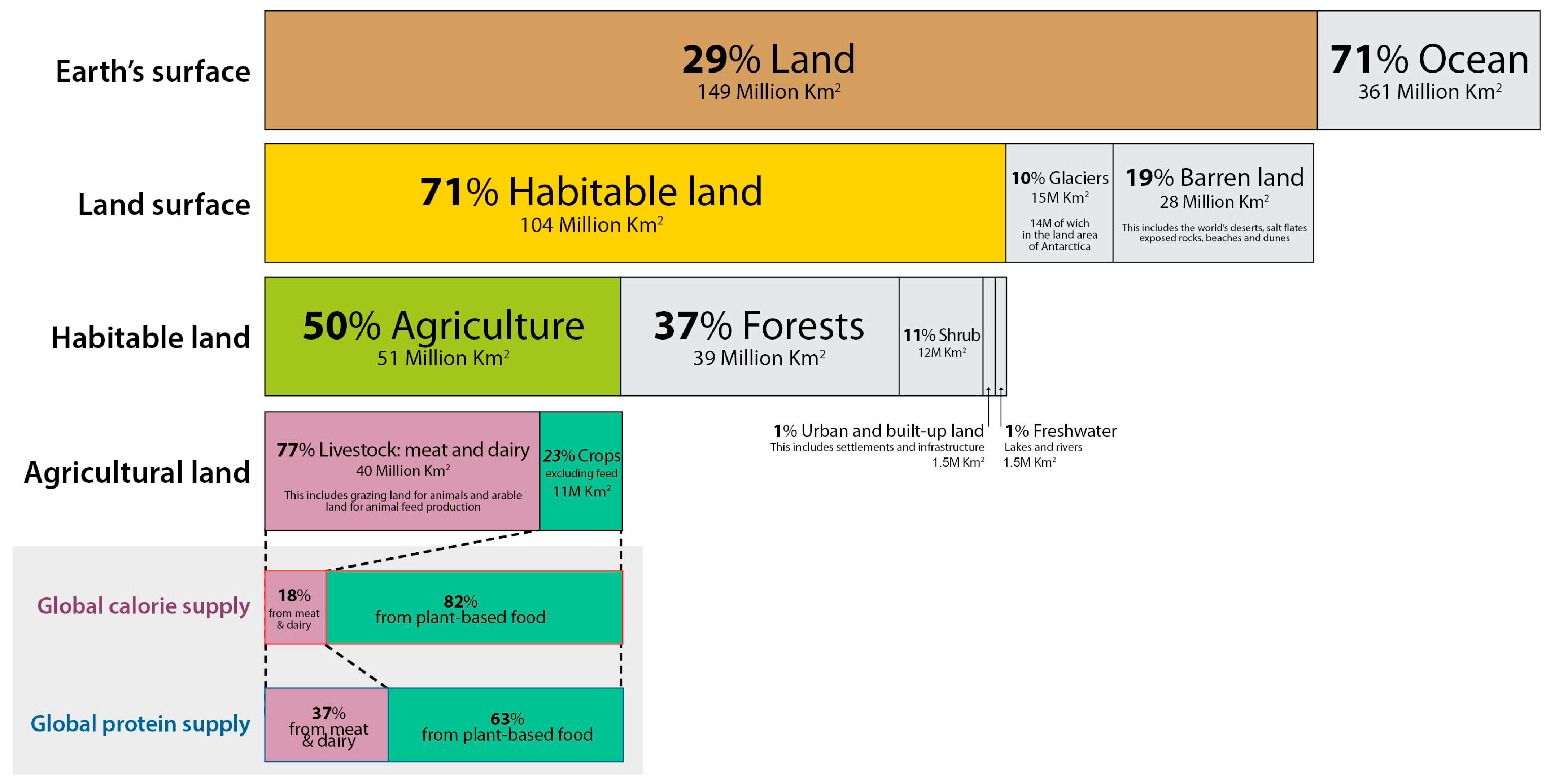
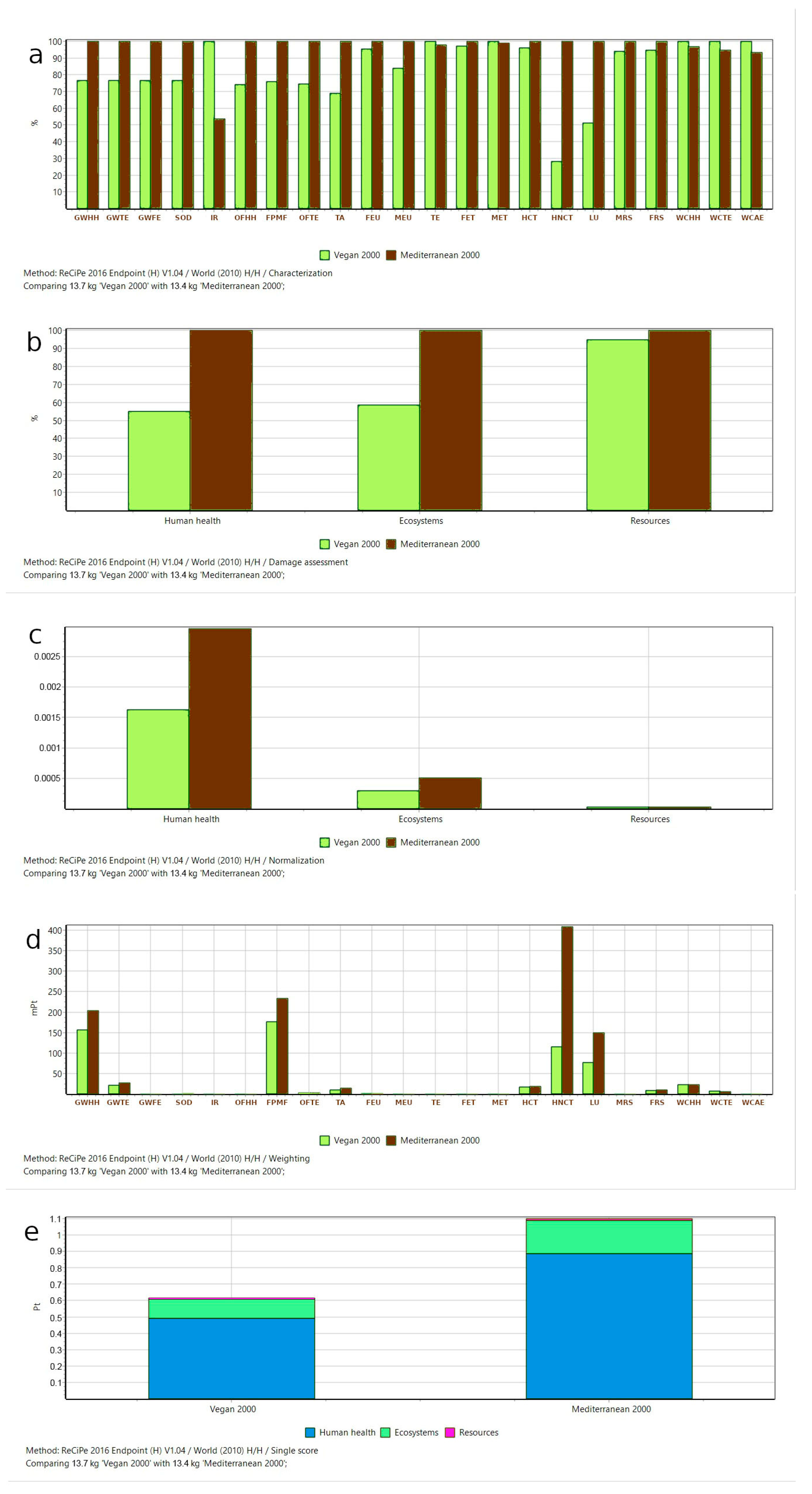
| a. Composition of the Two One-Week Diets. | ||||||
| Vegan | Mediterranean | |||||
| Food | Amount | Unit | Food | Amount | Unit | |
| Mixed grains (cooked) | 1.12 | kg | Mixed grains (cooked) | 1.12 | kg | |
| Rice (cooked) | 0.72 | kg | Rice (cooked) | 0.72 | kg | |
| Pasta (cooked) | 1.68 | kg | Pasta (cooked) | 1.68 | kg | |
| Bread | 0.66 | kg | Bread | 0.66 | kg | |
| Olive oil | 0.08 | kg | Olive oil | 0.14 | kg | |
| Mixed legumes (cooked) | 0.88 | kg | Mixed legumes (cooked) | 0.40 | kg | |
| Mixed fruit | 2.63 | kg | Mixed fruit | 2.10 | kg | |
| Vegetables (raw and cooked) | 4.20 | kg | Vegetables (raw and cooked) | 4.20 | kg | |
| Mixed nuts | 0.42 | kg | Mixed nuts | 0.40 | kg | |
| Sunflower oil | 0.06 | kg | Egg (cooked) | 0.12 | kg | |
| Soy dessert, plain, refrigerated | 0.25 | kg | Chicken (cooked) | 0.12 | kg | |
| Soy drink, plain, fortified with calcium | 0.80 | kg | Cheese | 0.21 | kg | |
| Seitan | 0.06 | kg | Fish (cooked) | 0.12 | kg | |
| Tofu | 0.16 | kg | Red meat (cooked) | 0.06 | kg | |
| Skimmed milk | 1.40 | kg | ||||
| b. Daily Average Nutritional Characteristics of the Two One-Week Diets. | ||||||
| Vegan | Mediterranean * | |||||
| Energy (kcal) | 2016.57 | 2018.57 | ||||
| Carbohydrates (%) | 52.93 | 49.76 | ||||
| Proteins (%) | 16.48 | 17.81 | ||||
| Fats (%) | 30.55 | 32.46 | ||||
| Fiber g (total/1000 kcal) | 24.14 | 21.09 | ||||
| Iron (mg) | 22.52 | 19.27 | ||||
| Calcium (mg) | 851.94 | 853.48 | ||||
| Zinc (mg) | 12.71 | 12.98 | ||||
| a. Characterization | ||||
| Impact Category | Unit | Vegan | Mediterranean | Δ Veg-Med |
| Global warming, Human health | DALY | 1.24 × 10−5 | 1.62 × 10−5 | −0.38 × 10−5 |
| Global warming, Terrestrial ecosystems | species.yr | 3.75 × 10−8 | 4.88 × 10−8 | −1.13 × 10−8 |
| Global warming, Freshwater ecosystems | species.yr | 1.02 × 10−12 | 1.33 × 10−12 | −0.31 × 10−12 |
| Stratospheric ozone depletion | DALY | 4.77 × 10−8 | 6.23 × 10−8 | −1.46 × 10−8 |
| Ionizing radiation | DALY | 6.13 × 10−9 | 3.28 × 10−9 | 2.84 × 10−9 |
| Ozone formation, Human health | DALY | 3.08 × 10−8 | 4.14 × 10−8 | −1.06 × 10−8 |
| Fine particulate matter formation | DALY | 1.40 × 10−5 | 1.85 × 10−5 | −0.45 × 10−5 |
| Ozone formation, Terrestrial ecosystems | species.yr | 4.45 × 10−9 | 5.98 × 10−9 | −1.53 × 10−9 |
| Terrestrial acidification | species.yr | 1.75 × 10−8 | 2.54 × 10−8 | −0.79 × 10−8 |
| Freshwater eutrophication | species.yr | 2.99 × 10−9 | 3.14 × 10−9 | −0.15 × 10−9 |
| Marine eutrophication | species.yr | 2.97 × 10−11 | 3.54 × 10−11 | −0.06 × 10−11 |
| Terrestrial ecotoxicity | species.yr | 5.56 × 10−10 | 5.43 × 10−10 | 0.12 × 10−10 |
| Freshwater ecotoxicity | species.yr | 5.22 × 10−10 | 5.37 × 10−10 | −0.16 × 10−10 |
| Marine ecotoxicity | species.yr | 8.87 × 10−11 | 8.78 × 10−11 | 0.09 × 10−11 |
| Human carcinogenic toxicity | DALY | 1.36 × 10−6 | 1.42 × 10−6 | −0.05 × 10−6 |
| Human non-carcinogenic toxicity | DALY | 9.08 × 10−6 | 32.36 × 10−6 | −23.28 × 10−6 |
| Land use | species.yr | 1.37 × 10−7 | 2.67 × 10−7 | −1.30 × 10−7 |
| Mineral resource scarcity | USD2013 | 1.64 × 10−2 | 1.75 × 10−2 | −0.11 × 10−2 |
| Fossil resource scarcity | USD2013 | 8.29 × 10−1 | 8.76 × 10−1 | −0.47 × 10−1 |
| Water consumption, Human health | DALY | 1.84 × 10−6 | 1.79 × 10−6 | 0.06 × 10−6 |
| Water consumption, Terrestrial ecosystem | species.yr | 1.18 × 10−8 | 1.12 × 10−8 | 0.06 × 10−8 |
| Water consumption, Aquatic ecosystems | species.yr | 4.17 × 10−12 | 3.89 × 10−12 | 0.28 × 10−12 |
| b. Damage Assessment | ||||
| Damage Category | Vegan | Mediterranean | Δ Veg-Med | |
| Human Health | DALY | 3.88 × 10−5 | 7.03 × 10−5 | −3.15 × 10−5 |
| Ecosystems | Species.yr | 2.12 × 10−7 | 3.63 × 10−7 | −1.50 × 10−7 |
| Resources | USD2013 | 0.8457 | 0.8933 | −0.0476 |
| c. Normalization | ||||
| Damage Category | Unit | Vegan | Mediterranean | Δ Veg-Med |
| Human Health | - | 1.63 × 10−3 | 2.96 × 10−3 | −1.33 × 10−3 |
| Ecosystems | - | 2.96 × 10−4 | 5.06 × 10−4 | −2.10 × 10−4 |
| Resources | - | 3.02 × 10−5 | 3.19 × 10−5 | −0.17 × 10−5 |
| Impact Category | Unit | Vegan | Mediterranean | Δ Veg-Med | % |
|---|---|---|---|---|---|
| Global warming, Human health | Pt | 1.57 × 10−1 | 2.04 × 10−1 | −0.47 × 10−1 | −23.21 |
| Global warming, Terrestrial ecosystem | Pt | 2.09 × 10−2 | 2.72 × 10−2 | −0.63 × 10−2 | −23.20 |
| Global warming, Freshwater ecosystem | Pt | 5.71 × 10−7 | 7.44 × 10−7 | −1.73 × 10−7 | −23.20 |
| Stratospheric ozone depletion | Pt | 6.03 × 10−4 | 7.87 × 10−4 | −1.84 × 10−4 | −23.40 |
| Ionizing radiation | Pt | 7.74 × 10−5 | 4.15 × 10−5 | 3.59 × 10−5 | 86.55 |
| Ozone formation, Human health | Pt | 3.89 × 10−4 | 5.23 × 10−4 | −1.34 × 10−4 | −25.69 |
| Fine particulate matter formation | Pt | 1.77 × 10−1 | 2.33 × 10−1 | −0.56 × 10−1 | −24.17 |
| Ozone formation, Terrestrial ecosystem | Pt | 2.48 × 10−3 | 3.34 × 10−3 | −0.85 × 10−3 | −25.55 |
| Terrestrial acidification | Pt | 9.79 × 10−3 | 14.19 × 10−3 | −4.40 × 10−3 | −31.04 |
| Freshwater eutrophication | Pt | 1.67 × 10−3 | 1.75 × 10−3 | −0.08 × 10−3 | −4.70 |
| Marine eutrophication | Pt | 1.66 × 10−5 | 1.97 × 10−5 | −0.32 × 10−5 | −15.95 |
| Terrestrial ecotoxicity | Pt | 3.10 × 10−4 | 3.03 × 10−4 | 0.07 × 10−4 | 2.24 |
| Freshwater ecotoxicity | Pt | 2.91 × 10−4 | 3.00 × 10−4 | −0.09 × 10−4 | −2.90 |
| Marine ecotoxicity | Pt | 4.95 × 10−5 | 4.90 × 10−5 | 0.05 × 10−5 | 0.98 |
| Human carcinogenic toxicity | Pt | 1.72 × 10−2 | 1.79 × 10−2 | −0.07 × 10−2 | −3.74 |
| Human non-carcinogenic toxicity | Pt | 1.15 × 10−1 | 4.09 × 10−1 | −2.94 × 10−1 | −71.95 |
| Land use | Pt | 0.76 × 10−1 | 1.49 × 10−1 | −0.73 × 10−1 | −48.78 |
| Mineral resource scarcity | Pt | 1.76 × 10−4 | 1.87 × 10−4 | −0.11 × 10−4 | −6.03 |
| Fossil resource scarcity | Pt | 8.88 × 10−3 | 9.38 × 10−3 | −0.50 × 10−3 | −5.32 |
| Water consumption, Human health | Pt | 2.33 × 10−2 | 2.26 × 10−2 | 0.07 × 10−2 | 3.13 |
| Water consumption, Terrestrial ecosystem | Pt | 6.58 × 10−3 | 6.23 × 10−3 | 0.35 × 10−3 | 5.55 |
| Water consumption, Aquatic ecosystem | Pt | 2.33 × 10−6 | 2.17 × 10−6 | 0.16 × 10−6 | 7.16 |
| Damage Category | |||||
| Human health | Pt | 4.90 × 10−1 | 8.88 × 10−1 | −3.98 × 10−1 | −44.83 |
| Ecosystems | Pt | 1.18 × 10−1 | 2.02 × 10−1 | −0.84 × 10−1 | −41.50 |
| Resources | Pt | 9.06 × 10−3 | 9.57 × 10−3 | −0.51 × 10−3 | −5.34 |
| Total | Pt | 6.17 × 10−1 | 11.00 × 10−1 | −4.83 × 10−1 | −43.88 |
Disclaimer/Publisher’s Note: The statements, opinions and data contained in all publications are solely those of the individual author(s) and contributor(s) and not of MDPI and/or the editor(s). MDPI and/or the editor(s) disclaim responsibility for any injury to people or property resulting from any ideas, methods, instructions or products referred to in the content. |
© 2023 by the authors. Licensee MDPI, Basel, Switzerland. This article is an open access article distributed under the terms and conditions of the Creative Commons Attribution (CC BY) license (https://creativecommons.org/licenses/by/4.0/).
Share and Cite
Filippin, D.; Sarni, A.R.; Rizzo, G.; Baroni, L. Environmental Impact of Two Plant-Based, Isocaloric and Isoproteic Diets: The Vegan Diet vs. the Mediterranean Diet. Int. J. Environ. Res. Public Health 2023, 20, 3797. https://doi.org/10.3390/ijerph20053797
Filippin D, Sarni AR, Rizzo G, Baroni L. Environmental Impact of Two Plant-Based, Isocaloric and Isoproteic Diets: The Vegan Diet vs. the Mediterranean Diet. International Journal of Environmental Research and Public Health. 2023; 20(5):3797. https://doi.org/10.3390/ijerph20053797
Chicago/Turabian StyleFilippin, Denise, Anna Rita Sarni, Gianluca Rizzo, and Luciana Baroni. 2023. "Environmental Impact of Two Plant-Based, Isocaloric and Isoproteic Diets: The Vegan Diet vs. the Mediterranean Diet" International Journal of Environmental Research and Public Health 20, no. 5: 3797. https://doi.org/10.3390/ijerph20053797
APA StyleFilippin, D., Sarni, A. R., Rizzo, G., & Baroni, L. (2023). Environmental Impact of Two Plant-Based, Isocaloric and Isoproteic Diets: The Vegan Diet vs. the Mediterranean Diet. International Journal of Environmental Research and Public Health, 20(5), 3797. https://doi.org/10.3390/ijerph20053797








